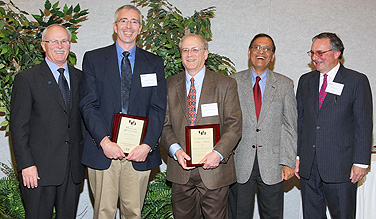News
Patented inventions double

Inventors Bradley Fuhrman (second from left) and Mark Dowhy (third from left) receive the 2008 UB Entrepreneurial Spirit Award. Also pictured are President John B. Simpson (far left), Provost Satish K. Tripathi (second from right) and STOR Director Robert Genco (far right). Photo: WILMACK PHOTOGRAPHY
-
 Print
Print -
 Comments
Comments
-
“The jump we saw this year in our patent activity is a testament to the intense and growing commitment we are seeing among our scientist-entrepreneurs, who increasingly seek ways to get their scientific advances out into society.”
Related links
An antibody with the potential to stop breast cancer in its path. A nanoparticle that can address a side effect of the treatment that hemophiliacs cannot live without. A “quantum dot” with the potential to treat cancer or harvest the power of the sun. An air purifier that kills the world’s nastiest toxins.
No, they’re not the stuff of science fiction.
These are some of the new inventions that were patented in 2008 by UB researchers, a year that has seen the number of UB patents more than double from nine in 2007 to 21 last year.
More than 40 of these UB researchers were honored last week at the UB Inventors and Entrepreneurs Reception for their efforts to bring their research out of the lab and into the marketplace.
The reception also honored 11 UB technologies that were licensed to industry and the three most recent “graduates” of UB’s Technology Incubator.
“The jump we saw this year in our patent activity is a testament to the intense and growing commitment we are seeing among our scientist-entrepreneurs, who increasingly seek ways to get their scientific advances out into society,” said Robert J. Genco, vice provost and director of the Office of Science, Technology Transfer and Economic Outreach (STOR), which co-sponsored the event with the Office of the Vice President for Research.
“They know that the most important scientific discovery in the world may provide little value to society if it goes no further than a journal publication,” he continued. “Today, UB is honoring its professors who have taken the critical steps toward using their scientific and technological expertise to address some of the world’s most profound problems.”
Genco and Kenneth M. Tramposch, associate vice president for research, addressed the inventors. President John B.Simpson and Provost Satish K. Tripathi also congratulated the inventors.
Some of the newly patented inventions are:
• An antibody with the potential to stop breast cancer metastasis. “The monoclonal antibody we developed has been shown to extend significantly the survival of mice with human breast-cancer tumors and to inhibit the cancer's spread to the lungs in the animals by more than 50 percent,” said lead investigator Kate Rittenhouse-Olson, associate professor of clinical and laboratory sciences, School of Medicine and Biomedical Sciences.
• A nanoparticle that treats hemophiliac patients who develop resistance to Factor VIII. “Our multifunctional, lipid nanoparticle improves the safety and efficacy of the protein by multiple mechanisms, improving stability of the protein, altering the immune response and making the particle stay in the blood longer,” said lead investigator Sathy Balu-Iyer, associate professor of pharmaceutical sciences, School of Pharmacy and Pharmaceutical Sciences.
• A quantum dot with the potential to treat cancer or harness solar energy. “Our process for synthesizing these silicon nanoparticles makes them potentially useful for various applications, including biological imaging and diagnostics, solar cells and light-emitting diodes,” said Mark T. Swihart, associate professor of chemical and biological engineering, School of Engineering and Applied Sciences and lead investigator.
• An air sterilizer that kills every biological agent it meets. “The BioBlower can rapidly and continuously kill airborne biological pathogens, such as anthrax, and it has demonstrated the ability to eradicate other airborne pathogens, such as avian flu, SARS and influenza viruses,” said James F. Garvey, professor of chemistry, College of Arts and Sciences, and lead investigator.
Also presented at the reception was the 2008 UB Entrepreneurial Spirit Award recognizing researchers who founded a company to license a UB technology. This year, it was presented to Bradley P. Fuhrman, professor of pediatrics and anesthesiology, School of Medicine and Biomedical Sciences, and chief of critical care, Women & Children's Hospital of Buffalo, and Mark Dowhy, director of the Pediatric Critical Care Laboratory, UB Department of Pediatrics.
The invention was licensed from UB to Medical Conservation Devices (MCD) of Buffalo, located in UB's New York State Center of Excellence in Bioinformatics and Life Sciences. Fuhrman and Dowhy are founding partners in MCD, which is raising funds to further develop the prototype for FDA medical-device evaluation.
The event also will honor the three “graduates” of the UB Technology Incubator, which now have expanded into their own space. They are:
• Absolute Energy, moving to Grand Island, a complete Energy Management Services and IT sourcing partner.
• Lynx Technologies, moving to Grand Island, provides companies managing large networking computing environments with high-availability, high-reliability systems.
• Integral Information Systems, moving to Buffalo, a developer of advanced analytical software and decision support systems for health care providers.

Reader Comments